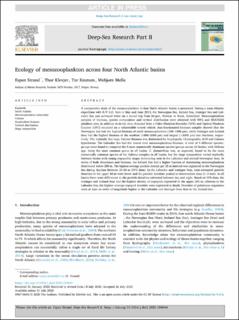| dc.description.abstract | A comparative study of the mesozooplankton in four North Atlantic basins is presented. During a trans-Atlantic expedition with R/V G.O. Sars in May and June 2013, the Norwegian Sea, Iceland Sea, Irminger Sea and Labrador Sea was surveyed twice on a round trip from Bergen, Norway to Nuuk, Greenland. Mesozooplankton samples of biomass, species composition and vertical distribution were obtained with WP2 and MOCNESS plankton nets, in addition to in situ data obtained from a Video Plankton Recorder (VPR) and Optical Plankton Counter (OPC) mounted on a submersible towed vehicle. Size-fractionated biomass samples showed that the Norwegian Sea had the highest biomass of small mesozooplankton (180–1000 μm), while Irminger and Iceland Seas had the highest biomass of the medium (1000–2000 μm) and largest (>2000 μm) size fractions, respectively. The Icelandic Sea large fraction biomass was dominated by Amphipods, Chaetognaths, Krill and Calanus hyperboreus. The Labrador Sea had the lowest total mesozooplankton biomass. A total of 9 different species/groups were found to comprise the 5 most numerically dominant species/groups across all basins, with Oithona spp. being the most common genus in all basins. C. finmarchicus was, as expected, found to be the most numerically common species of the Calanus complex in all basins, but the stage composition varied markedly between basins with young copepodite stages dominating only in the Labrador and central Norwegian Seas. In terms of both abundance and biomass, the Iceland Sea had a higher fraction of dominating mesozooplankton distributed below 200 m. The highest average particle density per 25 m interval was registered in the Norwegian Sea during daytime between 25-50 m (OPC data). In the Labrador and Irminger Seas, total estimated particle densities in the upper 50 m were lower and the particle densities peaked at intermediate sizes (1–3 mm). In all basins there were differences in the particle densities estimated between day and night. Based on VPR data, the Irminger and Iceland Seas had the highest density of copepods registered in the upper 200 m, whereas in the Labrador Sea, the highest average copepod densities were registered at depth. Densities of gelatinous organisms were at least an order of magnitude higher in the Labrador and Irminger Seas than in the Iceland Sea. | en_US |
